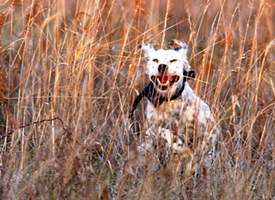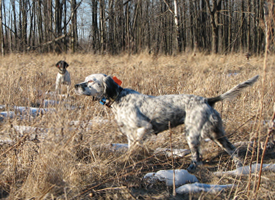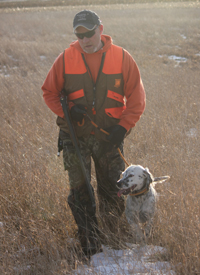
Training - Our Philosophy
 What are our thoughts? After many years of learning through our own experiences and research, we have formulated a philosophy that works for us and our clients. This philosophy continues to successfully serve as a foundation for meeting each dog's unique personality and the dog owner's needs. What are our thoughts? After many years of learning through our own experiences and research, we have formulated a philosophy that works for us and our clients. This philosophy continues to successfully serve as a foundation for meeting each dog's unique personality and the dog owner's needs.
Download The Fly-n-Gun Kennels Training Philosophy: What A Gun Dog Owner Should Know (pdf, 152 KB) or read it below.
This philosophy was written August 3, 2007 and still holds true today.
The Fly-n-Gun Kennel Training Philosophy
What A Bird Dog Owner Should Know
by Craig and Teri Steinbach
So you have a bird dog. Maybe this is your first or your third; it doesn't matter. You are looking to have a dog that will be a family member and hunting partner. You want the best of both worlds. So do we. It is no surprise that this is a huge challenge. We would like to help you and your family to rise to the challenge and have the dog you always wanted.
Our Background
Before we get into our thoughts on how to treat our dogs, what our dogs should do in the field, and the e-collar, we would like to share a bit about our background. In the late 1980s and early 1990s, Craig was an avid hound hunter. The lessons learned while working with his hounds aided in setting the foundation for our training philosophy. During this time he learned about how dogs act around each other and how dogs look at us, as well as how younger dogs can learn from older, more experienced dogs just by watching them and/or running with them. He realized the importance of having a dog hunt for us whether it was for coon, bear, or rabbit hunting. The training techniques he used then, although some may be modified, he still uses today.
 Bird dogs have been a part of Craig's life since 1993 when he began training and campaigning. We met in 1998, while working at a pheasant hunting preserve, began dating one year later, and were married in 2003. We both share a love of bird dogs and have been training as a team ever since. Over the years, we have relied on our experience as well as learned about other training methods. In doing so, we found success by combining our techniques with the Silent Command System™ since we have always believed that if we can make a dog work with us at our side, we can make him/her work with us out in the field. Bird dogs have been a part of Craig's life since 1993 when he began training and campaigning. We met in 1998, while working at a pheasant hunting preserve, began dating one year later, and were married in 2003. We both share a love of bird dogs and have been training as a team ever since. Over the years, we have relied on our experience as well as learned about other training methods. In doing so, we found success by combining our techniques with the Silent Command System™ since we have always believed that if we can make a dog work with us at our side, we can make him/her work with us out in the field.
How should we treat our dogs?
In order to best understand your dog, you need to see him/her as an animal. As much as we want to believe that they have human qualities, they are animals. Dogs function through instinct, living in packs and dealing with pecking order. Our dogs want to form strong bonds and attachments within their social group, as well as show affection and a need to protect those they are closest to (Smith 2006).
There are many things we do to show our dogs that we love them. For example, we may give them treats, cuddle with them on the couch, let them sleep on our bed at night, etc. According to Smith (2006), our dogs will appreciate and benefit from such means to show our love, however these acts do nothing to strengthen our dog's bond with us. In fact, he says that if such acts are not done properly, it can actually weaken the bond. Why? It all goes back to our dog's instincts.
We all love to show our dogs signs of affection. So, how do we do so without weakening the bond or losing our rank as pack leader? It's simple. Make sure that affection is done on your terms, not your dog's. For example, your dog may jump up on you to get your attention. If you give your dog attention when it jumps up on you, he/she has just trained you to provide a service to him/her. As a result of your action, your dog will think it has just moved ahead of you in the pack order. If you continue such actions with other situations such as begging for food or shoving your hand to get petted, your dog will lose respect for you.
Our dogs want us to show respect. To them this is the same as love. Yes, it is much harder to show respect than love. But, if we respect their ways and language, they will respect us. And, that respect will foster a wonderful relationship (Smith 2006). You will have your family member and hunting partner.
How do we show respect? We can show respect by giving the dog what it really needs: a home, exercise, food, rules, affection, and discipline. This means…
 Giving our dogs a home. Dogs are den animals and therefore love their own space. This can be accomplished by designating one spot, whether it is in the house or kennel, where they have a dog house, pillow, or kennel crate to call their own. This is also where you will want to feed and water your dog. After all, it is their home within your home. Giving our dogs a home. Dogs are den animals and therefore love their own space. This can be accomplished by designating one spot, whether it is in the house or kennel, where they have a dog house, pillow, or kennel crate to call their own. This is also where you will want to feed and water your dog. After all, it is their home within your home.
- Allowing our dogs to run and play. Bird dogs need to run for three to five miles in order to fulfill their exercise needs. A brisk walk on a leash just doesn't cut it.
- Feeding your dog a premium dog food and watching his/her weight. Don't leave food out all day long for your dog. You want your dog to look to you and depend on you for food.
- Setting boundaries and sticking with them, even when you have guests in your home. Maybe you don't want your dog to come onto the carpeted area of your house, or sleeping on the end of your bed is out of the question. Decide what your rules will be right away. We also recommend doing little things such as allowing your dog to come out of his/her kennel or kennel crate on your command. This way, everything is on your terms and you will maintain your position as pack leader.
- Showing affection. Dogs love belly rubs and playtime with you. Just be sure to keep playtime under control. Don't allow your dog to nip at you. This may lead to increased aggressiveness later on. Also, don't allow your dog to body check you, jump up on you, or jump up and push off of you. These actions are usually done behind your back and are signs of dominance. Your dog is no longer playing with you.
- Correcting your dog if necessary. If you don't, your dog will take advantage of you.
What should we expect our hunting dogs to do?
The most important thing that our dogs should do is hunt with us and for us, not for them. Your dog should be in tune to you as the leader of the team, covering the ground in front if you. If you move to the left, your dog should as well. When this relationship has been established you should let your dog do what it does best, that is find the birds. Respect your dog by not over handling. In doing so, your dog will remain focused and his/her self-confidence will not be eroded. Only interfere if your dog steps outside his/her role (Smith and Potter 2006).
 When your pointing dog finds a bird, he/she should stop on scent and point the bird until released by you. It is best that your dog remains motionless at this time in order to minimize that chance of flushing the bird. Furthermore, it is best that your pointing dog doesn't get too close to the bird. A dog that gets within sight of the bird before pointing is likely to flush the bird, costing you a shot (Smith and Potter 2006). Flushing breeds, on the other hand, should go in and flush the bird, then sit until your cue to release. This will carry over into the waterfowl hunt where you want your dog to remain in the blind until cued for a retrieve. When your pointing dog finds a bird, he/she should stop on scent and point the bird until released by you. It is best that your dog remains motionless at this time in order to minimize that chance of flushing the bird. Furthermore, it is best that your pointing dog doesn't get too close to the bird. A dog that gets within sight of the bird before pointing is likely to flush the bird, costing you a shot (Smith and Potter 2006). Flushing breeds, on the other hand, should go in and flush the bird, then sit until your cue to release. This will carry over into the waterfowl hunt where you want your dog to remain in the blind until cued for a retrieve.
For both flushing and pointing breeds, the release point is your choice. You may want your dog to release on your shot or release on your cue when game is down. However, we feel it is best to have your dog maintain point at least until the shot for your dog's safety.
The retrieval of the bird is expected for both flushing and pointing breeds. The bird should be brought back to you efficiently and in good condition. Don't allow your dog to strut around you, showing off the game, or drop the game a few feet in front of you. This is a sign of disrespect. Remember you are the leader of the team.
Backing is another skill that flushing and pointing breeds should master. A dog backs or honors another dog by stopping and sitting/pointing as soon as he/she sees another dog sitting/pointing. Backing should be an instinctive response since dogs work as a pack to make a kill. If a dog doesn't back, it is likely out of jealousy and wanting to steal a flush/point (Smith and Potter 2006). This is where you will need to utilize your role as the leader of the pack and correct your dog, keeping him/her in line.
The Electronic Collar
The e-collar, or electronic collar, is a valuable training and safety tool for your dog. Yes, safety tool. The e-collar is nothing to fear. It is not inhumane. Anyone who questions the humaneness of an e-collar hasn't experienced it for him- or herself. If fact, the e-collars that we use offer stimulation that often cannot be felt by the human hand.
We have sound techniques for introducing the e-collar to your dog. Training is conducted using the lowest simulation possible. It is also very important that you receive the proper training in regard to when and how to use the collar. Commands can be suited to your needs and overlaid with the voice. However, generally in our training, a momentary stimulation will cue a dog to go with us or come to us, and a constant stimulation will cue a dog to sit/stand still.
Final Thoughts
 If you are on board with our philosophy, the sky is the limit. The training we can offer your dog, coupled your ability to access these skills, will give you memories that will last a lifetime. You and you dog will have an enjoyable hunting partnership and respectful, loving relationship for many years to come. If you are on board with our philosophy, the sky is the limit. The training we can offer your dog, coupled your ability to access these skills, will give you memories that will last a lifetime. You and you dog will have an enjoyable hunting partnership and respectful, loving relationship for many years to come.
We would like to leave you with one final thought. When your dog gets up there in years and becomes arthritic, there is yet another way to bid your dog the respect he/she deserves: don't leave him/her home when you go hunting. "Respecting the dog means letting the dog go along and hunt, even if it's only for a short while, and it means going slower and taking it easy. It hurts the dog far more to be left behind…To give that pensioner a chance to keep doing what it enjoys, in whatever capacity it can perform, speaks volumes about the respect and love you have for that dog. Some folks worry about an older dog dying while hunting, but we can't think of a better way to go than doing something it loves so much" (Smith 2006, p. 18).
Resources:
Smith, R. 2006. Trainin' Dogs with Rick Smith: Respect or Love? The Pointing Dog Journal 14(2): 16-18.
Smith, R. and S. Potter. 2006. Trainin' Dogs with Rick Smith: What's a Bird Dog Supposed to Do? The Pointing Dog Journal 14(2): 26-28.
HOME | TRAINING | TITLING | ABOUT US
© Fly-n-Gun Kennels, L.L.C. |





